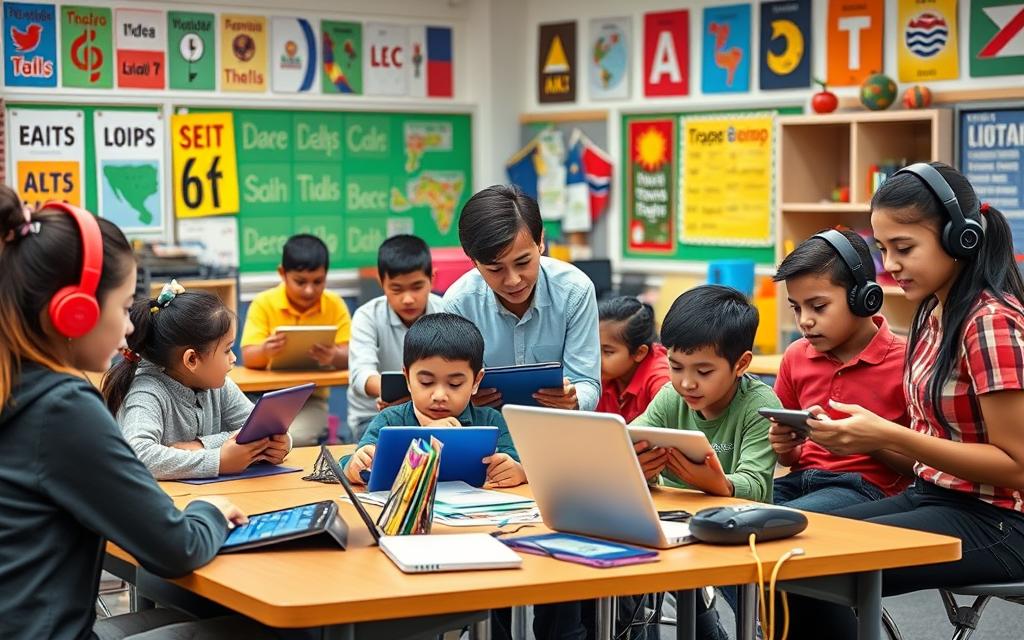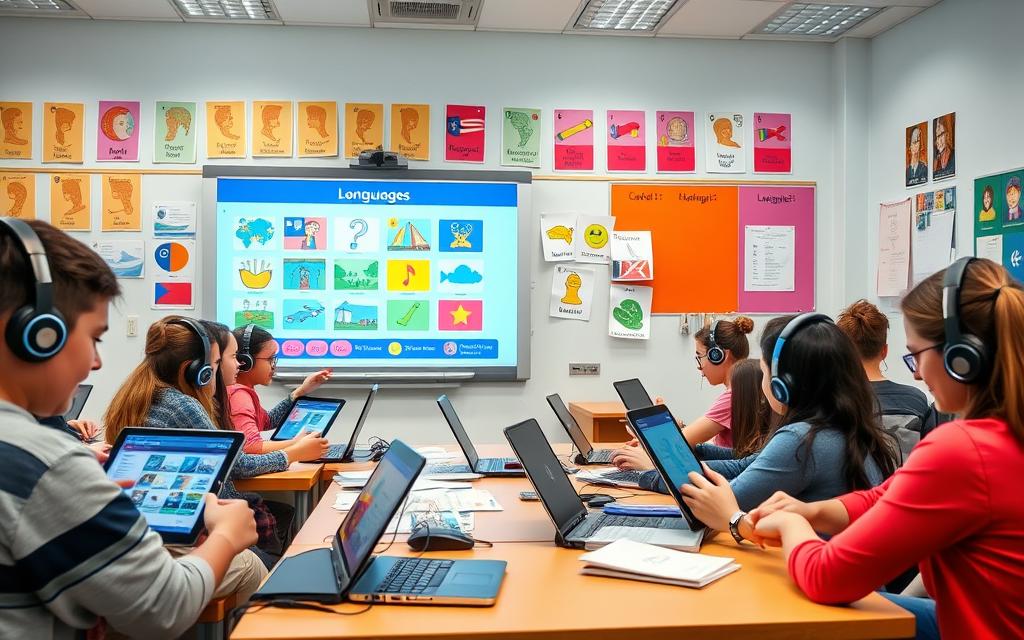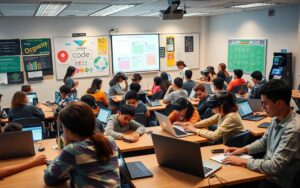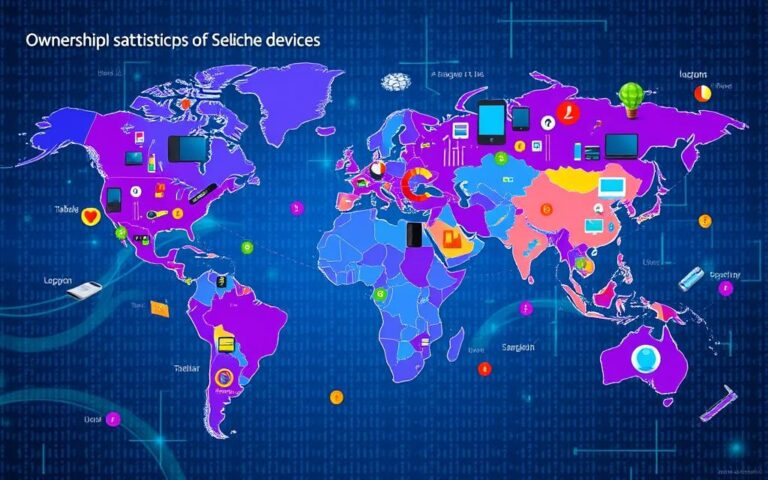How Technology Supports Language Learning and Communication
In today’s fast-changing world, technology in language learning brings new chances for both learners and teachers. The benefits of tech in communication are many, offering new ways to interact and learn. Digital tools make it easier to find and use lots of learning resources, making the learning process more fun and interactive.
As tech in education grows, students get to play a bigger role in learning languages. Sites like Duolingo make learning fun by turning it into a game. This keeps learners excited and helps them develop important skills. Tools like Grammarly also help improve writing by giving feedback on what you write.
Also, studies show that tech can really help teach languages, but teachers are still key. Working with skilled language teachers helps learners get better at talking and listening in real life. To get better at understanding different cultures, talking with teachers and other learners is very important. This mix of old and new ways of learning makes mastering languages possible and meaningful. To learn more about how tech is changing many areas, check out this resource.
The Evolution of Language Learning through Technology
Language learning has changed a lot over the years. It started with oral traditions and has been shaped by new technologies. Today, we see a big change in how we learn languages, thanks to digital tools.
Barriers Broken by Digital Tools
Before, learning a language was hard because of where you lived and what resources you had. Now, the internet has changed everything. It lets anyone learn a language from anywhere, anytime.
Old schools focused on memorising and translating texts. But now, we have interactive and multimedia-rich learning environments. This is a big change.
Overview of Language Learning Platforms
Platforms like Duolingo and Rosetta Stone show how technology has changed language learning. They offer different ways to learn, fitting different learning styles. AI and immersive tech make lessons more personal and effective.
Now, learners can dive into real materials from the cultures they’re learning about. This makes learning fun and effective.
The Role of Educators in Technology-Enhanced Learning
In language education, teachers play a key role with technology. They make sure tech tools fit with learning goals. Their knowledge helps create a place where students can grow and learn well.
Importance of Human Interaction in Learning
Good communication is key to learning. Human interaction is vital for motivation and interest in students. Studies show that smart use of technology can boost students’ social skills.
Teachers use tech to make lessons lively and interactive. This approach makes sure every student feels important and heard.
Guiding Student Learning with Technology
Teachers greatly influence students’ success with technology. They use digital tools to make lessons fit each student’s needs. For example, smartboards and apps change how we teach, making learning fun and clear.
These technologies help students use language in real ways. Research shows that tech can really improve learning.
Teachers keep learning to stay up-to-date and creative. Using tech helps them support students and create a space for discovery. This approach not only keeps students interested but also makes learning more effective in today’s fast-changing world.
| Aspect | Impact of Educators | Technology’s Role |
|---|---|---|
| Human Interaction | Builds motivation and engagement | Facilitates collaborative learning |
| Guidance | Addresses diverse learning needs | Offers tailored digital resources |
| Continuous Development | Adapts to new standards | Enhances teaching methods |
| Learning Environment | Promotes authentic communication | Supports innovative instructional strategies |
How Technology Aids Language Learning
In today’s world, technology is key in changing how we learn languages. It helps us get real learning materials and makes learning personal. This makes learning fun and effective.
Enhancing Access to Authentic Materials
Real materials are vital for getting into a new language. Technology lets us use podcasts, videos, and articles that show how people really speak. These help us improve our listening and reading skills.
They also teach us about culture and everyday talk. For instance, language apps use sounds and pictures to give us real language experiences. This helps us learn words and phrases in context.
Personalised Learning Experience
Now, learning a language is more about what you need. Technology helps tailor learning to each person. It looks at what you’re good at and what you need to work on.
This way, you learn at your own speed. Plus, there are tools for all ages. Kids can play word games, while younger ones use simpler apps. This makes learning fun and keeps you interested.
https://www.youtube.com/watch?v=AfBFqSm1mFg
| Language Learning Tool | Age Group | Main Feature |
|---|---|---|
| Duolingo | All ages | Gamified lessons |
| Rosetta Stone | Adults and teens | Immersion technique |
| Endless Alphabet | Toddlers | Interactive word exploration |
| Busuu | Teens and adults | Social interaction for practice |
| Babbel | Adults | Structured lessons |
Technology Tools for Language Practice
Technology has changed how we learn languages. Many apps now help students learn new languages. They make learning fun and interactive.
Popular Applications for Language Learners
Many apps are popular for helping people learn languages. They make learning fun and engaging. Here are a few examples:
- Duolingo – It teaches over 20 languages in a game-like way, making learning fun.
- Quizlet – Users can make digital flashcards and quizzes to learn new words.
- HelloTalk – It connects learners with native speakers for real conversations.
- Kahoot – It uses games to help with vocabulary and reading.
- Epic! – It offers thousands of audiobooks and eBooks to improve reading skills.
Gamification in Language Learning
Gamification has changed language learning. It makes learning fun and rewarding. Here are some ways it works:
- Progress tracking – Learners can see how far they’ve come and get rewards.
- Interactive challenges – Tasks make learners solve problems and use their knowledge.
- Collaborative play – Apps like Quizizz let students work together, making learning fun.
More and more students are learning new languages. These tools help them a lot. Gamification makes learning fun and effective.
Online Resources for Improved Communication
The digital age has given us many online tools to learn languages. Podcasts and audiobooks are great for listening and understanding. They offer a wide range of content for all interests and levels.
Podcasts and Audiobooks for Language Comprehension
Podcasts and audiobooks are excellent for improving language skills. With over 850,000 podcasts, you can find something that interests you. They help you learn new words, improve your listening, and get better at understanding.
Listening to different accents and expressions is key. It helps you get used to how people speak in real life.
Digital Communication Platforms for Real-Time Practice
Platforms like Zoom and Skype are great for practicing languages in real-time. They let you talk to native speakers and other learners. This boosts your speaking and listening skills and makes you more confident.
Talking to others in real-time helps you understand context and tone better. It’s like practicing in real-life situations, which is very important for learning a language.
The Importance of Differentiated Instruction
In today’s classrooms, it’s key to use differentiated instruction for language learning. This method helps teachers meet the needs of all students. Modern technology lets teachers create learning experiences that fit each student’s needs.
Using data to guide teaching helps teachers tailor their lessons. This way, they can adjust their teaching based on how students are doing.
Adapting Tools to Diverse Learner Needs
Good differentiation needs the right tools. Tools like Newsela offer articles at different reading levels. This helps students from grade 3 to 12.
EDpuzzle lets teachers make interactive videos with quizzes. This way, students can show what they know. SAS Curriculum Pathways also helps by offering interactive lessons that match state standards.
Using Data-Driven Approaches in Language Learning
Using data in teaching helps track how students are doing. This information helps teachers adjust their lessons. It makes sure students get the right help at the right time.
Michael Petrilli says these tools are like “differentiation on steroids.” They make teaching more personal. By always checking how students are doing, teachers can keep them on track to reach their goals.

| Tool | Description | Benefits for Differentiation |
|---|---|---|
| Newsela | Articles available at different lexile levels. | Caters to diverse reading abilities. |
| EDpuzzle | Interactive videos with embedded quizzes. | Assess understanding and engagement in real-time. |
| SAS Curriculum Pathways | Interactive resources aligned with standards. | Facilitates personalised instruction based on needs. |
Benefits of Mobile Learning Applications
Mobile learning apps change how we learn languages, offering many benefits. They let learners enjoy flexible language learning that suits them. This flexibility means studying can fit into any busy schedule.
Learning Anytime and Anywhere
One big mobile learning advantage is learning from anywhere. This freedom lets learners study without being tied to classrooms. Schools now give students devices to help them learn globally.
Engagement through Interactive Features
Interactive apps make learning fun and effective. They use quizzes, flashcards, and games to keep learners involved. These interactive language applications boost memory and learning skills.
Learning through apps can be more fun than old methods. Apps with social features help learners share and discuss ideas. This boosts learning by 25% and helps bridge cultural gaps.
In short, mobile learning apps are great for language education. They offer many mobile learning advantages and make learning fun and diverse. For more on the benefits, check out the article here.
Collaboration in Language Learning
Collaborative language learning is becoming more popular in education. It involves group projects that help students learn together. This way, they can share knowledge and grow their language skills.
Group Projects and Social Learning Platforms
Group projects make students more active and improve communication. Tools like Google Drive and Padlet help them work together. These tools let students share ideas, which helps them understand and remember better.
The social learning benefits of working together are huge. It lets students practice their language skills in a safe space. This makes them more fluent and confident.
Creating a Supportive Learning Environment
To make collaborative learning work, teachers need to create a supportive space. This means a place where everyone feels safe to speak up. With respect and inclusivity, group projects can really help students learn and grow together.
| Collaborative Tools | Features | Benefits |
|---|---|---|
| Google Drive | Real-time document editing | Enhanced collaboration and transparency |
| Padlet | Interactive bulletin boards | Creative idea sharing and organisation |
| Microsoft OneNote | Notetaking with multimedia support | Supports diverse learning styles |
| Quizlet | Flashcards and study sets | Encourages independent and collaborative learning |
Current Trends in Language Learning Technology
The world of language learning tech is changing fast. New tools are making learning languages more fun and effective. Generative AI tools are leading this change, offering content and feedback that really help students.
Studies show that 62% of students get a better grasp of the language. And 63% say they study more effectively with AI tools. It’s clear that tech is making a big difference in education.
Generative AI Tools in Education
AI is making a big impact in education, especially in language learning. Tools like speech recognition help learners improve their pronunciation quickly. They get instant feedback, which speeds up their progress.
Adaptive learning algorithms adjust lessons to fit each student’s needs. This makes learning more personal and effective. AI also helps with writing, suggesting better sentence structures and correcting grammar.
Future of Language Learning with Technology
The future of language learning looks even more exciting. Automated grading will save time, giving feedback right away. Tools for real-time translation will help learners understand more than just words.
Chatbots will get better at having conversations with students. Virtual and augmented reality will make learning feel more real. This will help learners apply what they’ve learned in real-life situations.
These advancements show how AI can change language learning. By using personalised learning, students can take control of their learning. This is why it’s important to embrace these new technologies.
| Trend | Description | Impact |
|---|---|---|
| Generative AI Tools | Personalised feedback and content delivery | 62% of students report better understanding |
| Speech Recognition | Immediate feedback on pronunciation | Improved fluency and speaking confidence |
| Adaptive Learning Algorithms | Customised content based on learner progress | More efficient learning paths |
| AI Writing Assistants | Grammar and structure suggestions | Increased writing speed and accuracy |
| Real-Time Translation | Contextual translation tools | Enhanced understanding of nuances |
| AI Chatbots | Conversational practice at varied complexity | Simulated real-world interactions |
Conclusion
The world of technology and language learning has changed a lot. It now offers new chances for both learners and teachers. Digital tools make learning more engaging and help improve language skills.
These changes are changing education for the better. It’s key for students and teachers to use new ways to learn. This makes learning more meaningful.
Artificial intelligence is leading this change. It helps with tasks like grading and gives insights into how students are doing. This makes learning more personal and helps students succeed in languages.
Using these smart systems makes learning more accessible. It also helps solve big problems in education.
Looking ahead, it’s important to keep a balance between tech and human touch. We must make sure AI respects human values and ethics. This will help create a welcoming place for everyone to learn.
In the end, combining technology and language learning is opening up a bright future. It’s a time of new chances for understanding and talking with people from different cultures.
FAQ
How has technology transformed language learning?
Technology has changed language learning a lot. Now, we have tools like Duolingo and Rosetta Stone. These tools help learners from anywhere to get real materials from other cultures. This makes learning a language easier.
What role do educators play in technology-enhanced learning?
Teachers are key in using technology for learning. They give one-on-one help and use fun methods. This helps students talk better in real situations.
What types of digital tools are beneficial for language mastery?
Tools like Quizlet and HelloTalk make learning fun. They help with words and grammar. These tools also keep students interested with cool features.
How can personalised learning improve language acquisition?
Personalised learning fits learning to each person’s needs. It helps learners get better faster. This way, everyone learns at their own pace.
In what ways do online resources enhance language comprehension?
Online stuff like podcasts and audiobooks are great. They let learners hear real language. With so many podcasts, students can find something they like and can understand.
Why is differentiated instruction important in language learning?
Different teaching methods meet different learners’ needs. Tools like Newsela adjust to each student’s level. This way, everyone can learn at their own speed.
What are the advantages of mobile learning applications?
Mobile apps let learners study anytime, anywhere. They have games and quizzes to keep things fun. This makes learning a language a regular habit.
How does collaboration impact language learning?
Working together makes learning fun. Tools like Google Drive help students share and learn from each other. This makes learning better for everyone.
What current trends are shaping language learning technology?
New AI tools are changing learning. They give feedback and make learning easier. These changes will make learning even better in the future.









